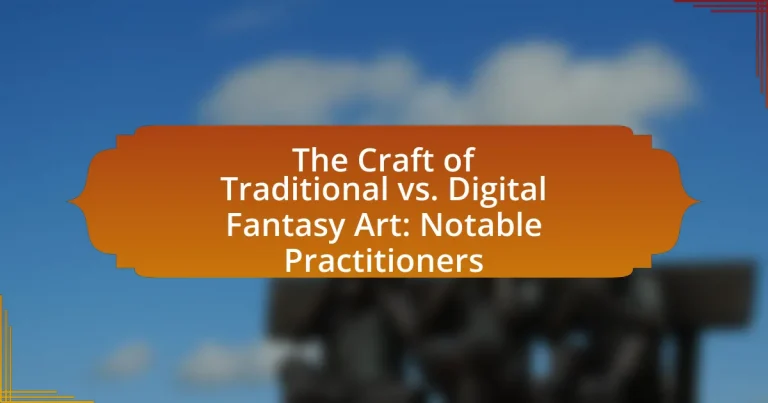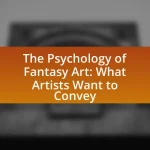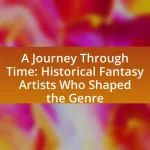The article examines the craft of traditional versus digital fantasy art, highlighting the distinct techniques, tools, and artistic expressions associated with each medium. It outlines the characteristics of traditional fantasy art, which relies on physical materials and techniques such as painting and sculpting, and contrasts this with digital fantasy art, which utilizes software and digital tools for creation. The discussion includes notable practitioners in both fields, their unique styles, and the historical contexts that have shaped their work. Additionally, the article explores how the differences in medium influence artistic expression, audience perception, and the evolution of fantasy art over time.
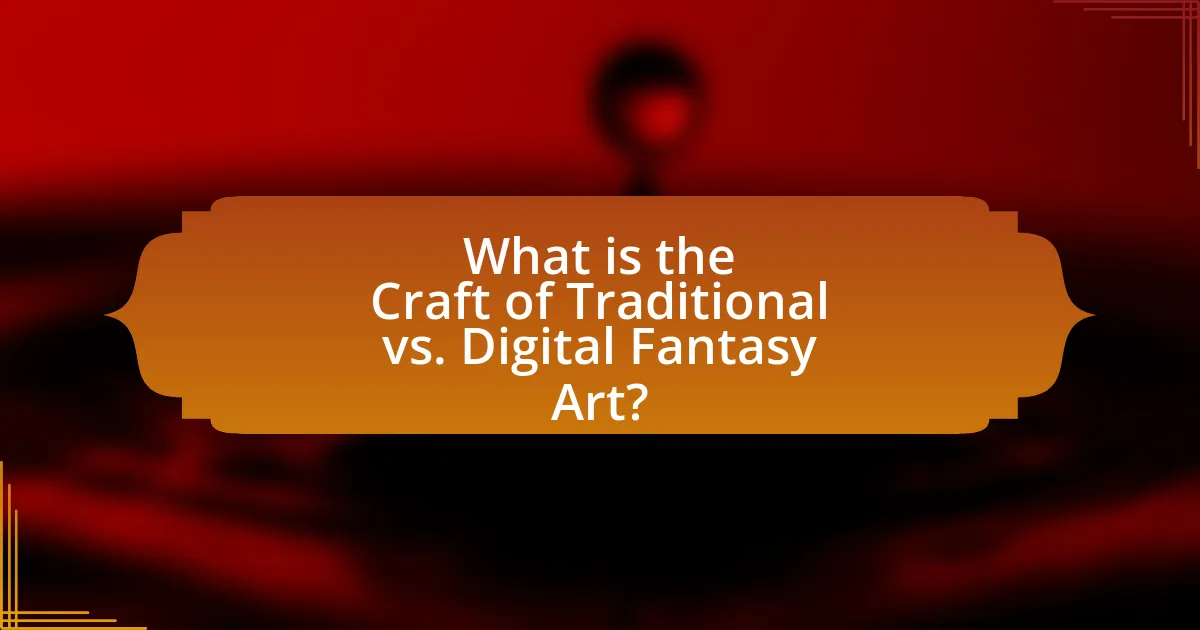
What is the Craft of Traditional vs. Digital Fantasy Art?
The craft of traditional fantasy art involves techniques such as painting, drawing, and sculpting using physical materials like oils, watercolors, and clay, while digital fantasy art utilizes software and digital tools to create artwork. Traditional artists often rely on their mastery of physical mediums, which can include layering, texture, and brushwork, while digital artists leverage technology for precision, ease of editing, and the ability to experiment with various styles and effects. The distinction is evident in the tools used; traditional artists may use canvas and brushes, whereas digital artists use tablets and software like Adobe Photoshop or Procreate. This difference in medium influences the workflow, with traditional art often requiring more time for drying and setup, while digital art allows for quicker iterations and modifications.
How do traditional and digital fantasy art differ in techniques?
Traditional and digital fantasy art differ primarily in their mediums and methods of creation. Traditional fantasy art utilizes physical materials such as paints, pencils, and canvases, which require techniques like layering, blending, and brushwork to achieve desired effects. In contrast, digital fantasy art employs software tools and digital devices, allowing for techniques such as layering in a digital environment, using brushes that can mimic traditional tools, and the ability to easily undo or modify elements without physical limitations. This distinction is evident in the workflow; traditional artists often work in a linear fashion, while digital artists can manipulate their work non-linearly, enhancing flexibility and experimentation.
What are the key characteristics of traditional fantasy art?
Traditional fantasy art is characterized by its imaginative themes, detailed craftsmanship, and vibrant color palettes. This genre often features mythical creatures, epic landscapes, and heroic figures, drawing inspiration from folklore, mythology, and literature. The use of traditional mediums such as oil paints, watercolors, and ink allows for rich textures and depth, enhancing the visual storytelling. Artists like Frank Frazetta and Boris Vallejo exemplify these characteristics through their iconic works, which showcase dynamic compositions and a strong sense of movement, further solidifying the genre’s appeal and impact in visual culture.
What are the defining features of digital fantasy art?
Digital fantasy art is characterized by its use of digital tools and software to create imaginative and otherworldly visuals. This art form often features vibrant colors, intricate details, and fantastical elements such as mythical creatures, surreal landscapes, and imaginative characters. The defining features also include the ability to easily manipulate layers, textures, and effects, allowing artists to experiment and refine their work with precision. Additionally, digital fantasy art often incorporates techniques like digital painting, 3D modeling, and photo manipulation, which enhance the depth and realism of the artwork. These features collectively enable artists to push the boundaries of creativity and produce visually stunning representations of fantasy worlds.
Why is the distinction between traditional and digital fantasy art important?
The distinction between traditional and digital fantasy art is important because it influences the techniques, tools, and creative processes artists employ. Traditional fantasy art typically involves physical mediums such as paint, pencil, or ink, which can create unique textures and depth, while digital fantasy art utilizes software and digital tools, allowing for greater flexibility, ease of editing, and the ability to replicate styles quickly. This distinction affects not only the final aesthetic of the artwork but also the accessibility and distribution methods for artists. For instance, digital art can be shared globally with minimal cost, while traditional art often requires physical transportation and exhibition. Understanding these differences helps in appreciating the diverse skill sets and artistic expressions within the fantasy art community.
How does this distinction influence artistic expression?
The distinction between traditional and digital fantasy art significantly influences artistic expression by shaping the techniques, accessibility, and creative possibilities available to artists. Traditional artists often rely on physical materials like paint and canvas, which can lead to a tactile and organic quality in their work, while digital artists utilize software and tools that allow for rapid experimentation and manipulation of images. This difference in medium affects not only the final aesthetic but also the workflow; for instance, digital art enables easy corrections and layering, fostering a different approach to creativity. Furthermore, the accessibility of digital tools has democratized art creation, allowing a broader range of individuals to express themselves artistically, which can lead to diverse styles and innovations in the genre.
What impact does the medium have on audience perception?
The medium significantly influences audience perception by shaping how art is experienced and interpreted. Traditional mediums, such as oil or watercolor, often evoke a sense of nostalgia and authenticity, while digital mediums can convey modernity and innovation. Research indicates that audiences perceive traditional art as more valuable and emotionally resonant, as evidenced by a study published in the Journal of Cultural Economics, which found that artworks created with traditional techniques are often associated with higher market prices and deeper emotional connections. Conversely, digital art is frequently viewed as more accessible and versatile, appealing to a broader audience due to its integration with technology and social media platforms. This distinction in perception underscores the importance of medium in the reception and valuation of artistic works.
What are the historical contexts of traditional and digital fantasy art?
Traditional fantasy art has its roots in ancient mythology and folklore, with notable examples found in medieval manuscripts and Renaissance paintings that depicted fantastical creatures and scenes. Artists like Hieronymus Bosch and Gustave Doré contributed significantly to this genre, using techniques such as oil painting and engraving to bring imaginative worlds to life.
In contrast, digital fantasy art emerged in the late 20th century with the advent of computer technology and software like Adobe Photoshop. This shift allowed artists to create intricate designs and manipulate images with unprecedented ease. The rise of the internet and digital platforms further facilitated the sharing and evolution of digital fantasy art, leading to a diverse community of artists who utilize tools like 3D modeling and digital painting.
The historical contexts of both forms reflect their respective technological advancements and cultural influences, with traditional art grounded in historical practices and digital art representing a modern evolution of those techniques.
How has traditional fantasy art evolved over time?
Traditional fantasy art has evolved significantly from its early origins in medieval manuscripts and illustrations to contemporary interpretations influenced by various artistic movements. Initially, fantasy art was characterized by religious and mythological themes, often depicted in illuminated manuscripts, such as those from the 12th to 15th centuries, where artists like the Limbourg brothers showcased intricate details and vibrant colors.
As the Renaissance emerged, artists began to incorporate more realistic human figures and landscapes, exemplified by works from artists like Sandro Botticelli, who infused mythological subjects with a sense of realism. The 19th century saw the rise of the Romantic movement, where artists like Gustave Moreau and Arthur Rackham introduced a more emotional and imaginative approach, blending fantasy with symbolism and personal expression.
In the 20th century, the advent of new media and techniques, such as watercolor and oil painting, allowed for greater experimentation, with artists like Frank Frazetta and Boris Vallejo pushing the boundaries of fantasy art through dynamic compositions and muscular figures. The late 20th and early 21st centuries have witnessed a further shift with the integration of digital tools, allowing artists to blend traditional techniques with digital mediums, exemplified by practitioners like Donato Giancola, who combines classical painting methods with digital enhancements.
This evolution reflects broader cultural shifts and technological advancements, showcasing how traditional fantasy art has adapted while maintaining its core themes of imagination and storytelling.
What milestones mark the development of digital fantasy art?
The development of digital fantasy art is marked by several key milestones, including the introduction of personal computers in the 1980s, the release of software like Adobe Photoshop in 1988, and the emergence of digital painting techniques in the 1990s. The advent of personal computers allowed artists to create and manipulate images digitally, fundamentally changing the art-making process. Adobe Photoshop provided powerful tools for digital manipulation and painting, becoming a standard in the industry. In the 1990s, artists began to adopt digital painting techniques, leading to the rise of notable digital fantasy artists such as Greg Rutkowski and Feng Zhu, who showcased the potential of digital mediums in fantasy art. These milestones collectively illustrate the evolution and acceptance of digital fantasy art within the broader art community.

Who are the notable practitioners in traditional fantasy art?
Notable practitioners in traditional fantasy art include Frank Frazetta, Boris Vallejo, and Julie Bell. Frank Frazetta is renowned for his dynamic compositions and muscular figures, significantly influencing the fantasy genre since the 1960s. Boris Vallejo is celebrated for his hyper-realistic depictions of fantasy scenes and characters, often featuring mythological themes. Julie Bell, known for her collaboration with Vallejo, combines traditional techniques with a modern aesthetic, creating striking fantasy illustrations. These artists have shaped the visual landscape of fantasy art through their distinctive styles and contributions.
What techniques do notable traditional fantasy artists employ?
Notable traditional fantasy artists employ techniques such as oil painting, watercolor, and ink drawing to create their works. These methods allow for rich textures and vibrant colors, essential for depicting fantastical elements. For instance, oil painting provides depth and luminosity, while watercolor offers a fluidity that can evoke ethereal landscapes. Additionally, ink drawing is often used for detailed line work, enhancing the intricacy of character designs and environments. Artists like Frank Frazetta and Brian Froud have effectively utilized these techniques, contributing to the genre’s visual language and establishing a legacy that influences contemporary fantasy art.
Which materials are commonly used by these artists?
Artists in traditional fantasy art commonly use materials such as oil paints, acrylics, watercolors, pastels, and various types of paper or canvas. These materials allow for a range of textures and effects, essential for creating detailed and imaginative scenes. In contrast, digital fantasy artists typically utilize software like Adobe Photoshop or Procreate, along with digital tablets and styluses, enabling them to manipulate colors and layers with precision. The choice of materials directly influences the artistic style and techniques employed by these practitioners, highlighting the differences between traditional and digital methods in fantasy art.
How do these artists develop their unique styles?
Artists develop their unique styles through a combination of personal experiences, experimentation with techniques, and influences from various art movements. For instance, many artists draw inspiration from their cultural backgrounds, which shapes their thematic choices and visual language. Additionally, they often experiment with different mediums, such as traditional painting or digital tools, allowing them to discover distinctive methods that resonate with their artistic vision. This process is further informed by studying the works of other artists, leading to a synthesis of styles that reflects both individual creativity and broader artistic trends.
What contributions have notable traditional artists made to the genre?
Notable traditional artists have significantly shaped the genre of fantasy art through their unique techniques and imaginative storytelling. Artists like Frank Frazetta and Boris Vallejo have popularized the depiction of heroic figures and mythical creatures, influencing the visual language of fantasy across various media. Frazetta’s dynamic compositions and Vallejo’s vibrant color palettes have set standards for character design and scene creation, inspiring countless contemporary artists. Their works have been pivotal in establishing fantasy art as a respected genre, with Frazetta’s paintings often cited as foundational in the development of modern fantasy illustration.
How have their works influenced contemporary fantasy art?
The works of notable practitioners in traditional and digital fantasy art have significantly influenced contemporary fantasy art by establishing foundational styles, techniques, and thematic elements. Artists like Frank Frazetta and H.R. Giger have set benchmarks for character design and atmospheric environments, which contemporary artists often reference or build upon. For instance, Frazetta’s dynamic compositions and Giger’s biomechanical aesthetics have inspired a generation of artists to explore similar motifs, leading to a rich visual language in modern fantasy art. Additionally, the transition from traditional to digital mediums has allowed for the integration of these classic influences into new forms, enabling artists to experiment with techniques that blend the old with the new, thus shaping the evolution of the genre.
What themes are prevalent in their artwork?
Prevalent themes in the artwork of notable practitioners in traditional and digital fantasy art include exploration of mythology, the juxtaposition of nature and technology, and the representation of identity and transformation. These themes are often reflected in their use of vibrant colors, intricate details, and imaginative landscapes. For instance, many artists draw inspiration from folklore and legends, creating pieces that evoke a sense of wonder and nostalgia. Additionally, the contrast between organic elements and futuristic motifs highlights the tension between the natural world and technological advancement, a common narrative in contemporary fantasy art. Furthermore, the exploration of identity is frequently depicted through character design and storytelling, allowing artists to convey personal and cultural narratives.
Who are some iconic figures in traditional fantasy art?
Some iconic figures in traditional fantasy art include Frank Frazetta, Boris Vallejo, and Julie Bell. Frank Frazetta is renowned for his dynamic compositions and muscular figures, significantly influencing the fantasy genre and popularizing the sword and sorcery aesthetic. Boris Vallejo is celebrated for his vivid and detailed illustrations, often featuring heroic characters and mythical creatures, which have graced numerous book covers and calendars. Julie Bell, known for her collaboration with Vallejo, combines realism with fantasy, creating striking images that often depict powerful women and fantastical beasts. These artists have left a lasting impact on the visual representation of fantasy, shaping the genre’s artistic direction.
What are the signature works of these artists?
The signature works of notable practitioners in traditional and digital fantasy art include “The Lord of the Rings” illustrations by Alan Lee, “The Art of Magic: The Gathering” series by Rebecca Guay, and “The Witcher” concept art by Kasia Babis. Alan Lee’s illustrations for J.R.R. Tolkien’s works have defined the visual landscape of Middle-earth, earning him an Academy Award for Best Art Direction. Rebecca Guay’s contributions to Magic: The Gathering have significantly influenced the game’s aesthetic, showcasing her unique style. Kasia Babis’s concept art for “The Witcher” series has shaped the visual identity of the franchise, contributing to its critical and commercial success.
How have these artists shaped the perception of fantasy art?
These artists have significantly shaped the perception of fantasy art by blending traditional techniques with digital innovation, thereby expanding the genre’s reach and appeal. For instance, artists like Frank Frazetta and Boris Vallejo established a visual language that emphasized dynamic compositions and vivid colors, which became foundational in fantasy illustration. Their work influenced not only book covers and movie posters but also the broader visual culture surrounding fantasy, leading to increased popularity and acceptance of the genre. Additionally, contemporary digital artists such as Yoshitaka Amano and Greg Rutkowski have utilized digital tools to create intricate and immersive worlds, further pushing the boundaries of what fantasy art can represent. This evolution has resulted in a diverse array of styles and interpretations, making fantasy art more accessible and appreciated across various audiences.
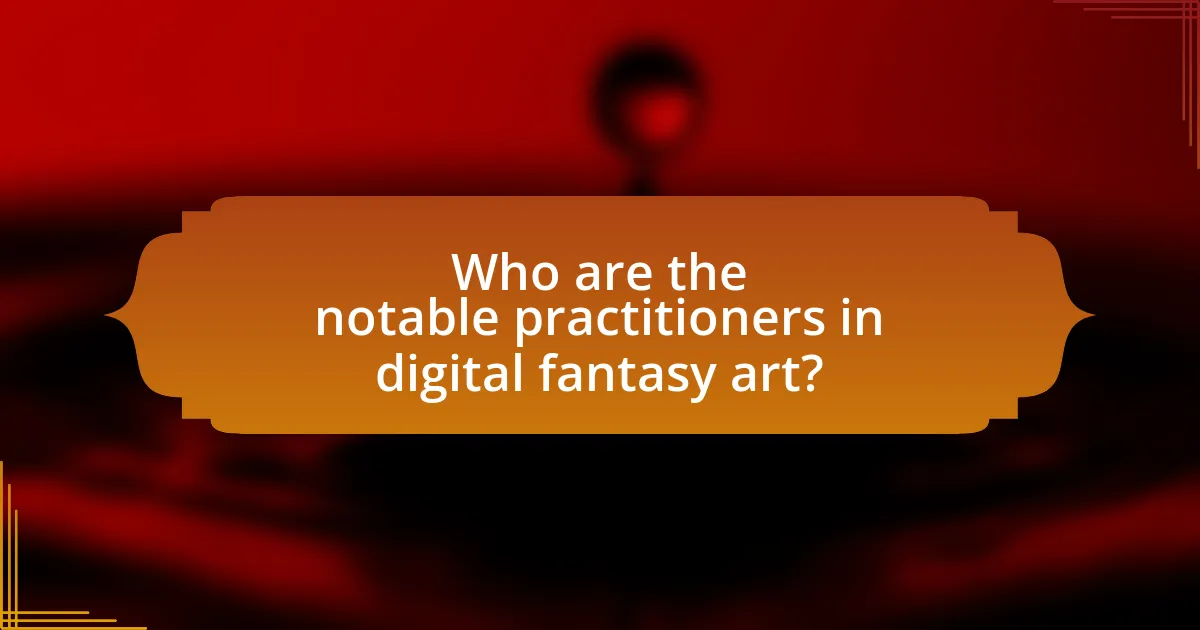
Who are the notable practitioners in digital fantasy art?
Notable practitioners in digital fantasy art include artists such as Yoshitaka Amano, known for his work on the Final Fantasy series, and Greg Rutkowski, recognized for his detailed illustrations and contributions to concept art. Additionally, artists like Feng Zhu, who has a significant influence in the gaming industry, and Artgerm (Stanley Lau), celebrated for his character designs and vibrant artwork, are also prominent figures in this field. Their works have garnered substantial recognition and have shaped the landscape of digital fantasy art through innovative techniques and unique styles.
What techniques do notable digital fantasy artists use?
Notable digital fantasy artists use techniques such as digital painting, 3D modeling, and photo manipulation. Digital painting allows artists to create intricate details and vibrant colors using software like Adobe Photoshop or Corel Painter, which facilitates layering and blending. 3D modeling, often done in programs like Blender or ZBrush, enables artists to construct complex characters and environments that can be rendered from multiple angles. Photo manipulation involves integrating real-world images into digital compositions, enhancing realism and depth. These techniques are widely recognized in the industry, as evidenced by the success of artists like Feng Zhu and Ian Sprigger, who utilize these methods to produce award-winning works.
What software and tools are essential for digital fantasy art creation?
Essential software and tools for digital fantasy art creation include Adobe Photoshop, Corel Painter, and Procreate. Adobe Photoshop is widely used for its extensive features in digital painting and photo manipulation, making it a staple among artists. Corel Painter offers a realistic painting experience with its natural media brushes, appealing to those who prefer a traditional art feel in a digital format. Procreate is favored for its user-friendly interface and powerful capabilities on the iPad, allowing artists to create detailed artwork on the go. These tools are recognized in the industry for their effectiveness in producing high-quality digital fantasy art.
How do these artists incorporate technology into their work?
Artists incorporate technology into their work by utilizing digital tools and software to create, enhance, and distribute their art. For instance, many artists use graphic tablets and software like Adobe Photoshop or Procreate to produce digital illustrations, allowing for greater precision and flexibility compared to traditional methods. Additionally, some artists integrate 3D modeling software, such as Blender or ZBrush, to create complex fantasy environments and characters, which can be rendered and animated for various media. This technological integration not only streamlines the creative process but also expands the possibilities for artistic expression and audience engagement through digital platforms.
What impact have notable digital artists had on the fantasy art landscape?
Notable digital artists have significantly transformed the fantasy art landscape by introducing innovative techniques and expanding accessibility to the medium. Artists like Yoshitaka Amano and Greg Rutkowski have pioneered styles that blend traditional aesthetics with digital tools, influencing both emerging and established creators. Their work has led to a broader acceptance of digital art in galleries and exhibitions, as evidenced by Amano’s contributions to the Final Fantasy series, which have garnered critical acclaim and a dedicated fanbase. Furthermore, platforms like ArtStation have democratized the sharing of digital art, allowing artists to showcase their work globally, thus fostering a vibrant community that continuously pushes the boundaries of fantasy art.
How have their innovations changed the way fantasy art is created and consumed?
Innovations in digital tools and platforms have significantly transformed the creation and consumption of fantasy art. Digital painting software, such as Adobe Photoshop and Procreate, allows artists to experiment with techniques and styles that were previously difficult or impossible with traditional media, enabling faster iterations and more complex compositions. Additionally, online platforms like ArtStation and social media have democratized access to fantasy art, allowing artists to showcase their work globally and engage directly with audiences, which has increased visibility and opportunities for collaboration. This shift has led to a more diverse range of artistic expressions and has fostered a community where feedback and inspiration are readily exchanged, ultimately reshaping the landscape of fantasy art.
What trends have emerged from their contributions?
Emerging trends from the contributions of notable practitioners in traditional and digital fantasy art include the blending of techniques from both mediums, increased accessibility of digital tools, and a growing emphasis on community engagement through social media platforms. The fusion of traditional painting methods with digital techniques allows artists to create hybrid works that leverage the strengths of both forms, enhancing visual storytelling. The rise of affordable software and hardware has democratized art creation, enabling a broader range of artists to participate in the fantasy art genre. Additionally, artists are increasingly using platforms like Instagram and ArtStation to share their work, fostering collaboration and feedback within the community, which has led to a more interconnected and diverse artistic landscape.
Who are some leading figures in digital fantasy art?
Some leading figures in digital fantasy art include Greg Rutkowski, Artgerm (Stanley Lau), and Feng Zhu. Greg Rutkowski is known for his highly detailed and imaginative landscapes, often featured in video games and concept art. Artgerm, a prominent illustrator, has gained recognition for his vibrant character designs and has a significant following on social media platforms. Feng Zhu is celebrated for his work in concept design for films and games, and he also runs an educational platform for aspiring artists. These artists have significantly influenced the digital fantasy art landscape through their unique styles and contributions to the industry.
What are their most recognized pieces?
The most recognized pieces in the realm of traditional and digital fantasy art include “The Lord of the Rings” illustrations by Alan Lee, “The Art of Magic: The Gathering” series by various artists, and “World of Warcraft” artwork by Samwise Didier. Alan Lee’s illustrations for J.R.R. Tolkien’s works have won numerous awards, including the 2001 Academy Award for Best Art Direction for “The Lord of the Rings: The Fellowship of the Ring.” The “Magic: The Gathering” series features contributions from multiple renowned artists, showcasing a diverse range of styles and themes that have become iconic in the gaming community. Samwise Didier’s artwork for “World of Warcraft” has significantly influenced the visual identity of the game, contributing to its status as a cultural phenomenon.
How do their styles differ from traditional fantasy artists?
Digital fantasy artists differ from traditional fantasy artists primarily in their use of technology and techniques. Digital artists leverage software tools like Photoshop and Procreate, allowing for greater flexibility, rapid iteration, and the ability to easily manipulate elements within their artwork. In contrast, traditional artists typically rely on physical mediums such as paint, ink, or pencil, which can limit their ability to make changes once a piece is underway. This technological advantage enables digital artists to experiment with styles and effects that may be more challenging or time-consuming for traditional artists to achieve, such as intricate layering and blending. Additionally, digital art often incorporates elements of animation and interactivity, which are not feasible in traditional formats.
What are the best practices for aspiring artists in both traditional and digital fantasy art?
Aspiring artists in both traditional and digital fantasy art should focus on mastering foundational skills, developing a unique style, and engaging with the art community. Mastering foundational skills, such as anatomy, perspective, and color theory, is essential as these elements form the basis of effective artwork. Developing a unique style allows artists to stand out in a competitive field; this can be achieved through experimentation and consistent practice. Engaging with the art community, whether through social media platforms, art forums, or local workshops, provides valuable feedback and networking opportunities that can enhance an artist’s growth. These practices are supported by the fact that artists who actively participate in communities often report higher levels of motivation and improvement in their work.
How can artists effectively blend techniques from both mediums?
Artists can effectively blend techniques from both traditional and digital mediums by utilizing the strengths of each to enhance their creative process. For instance, they can start with traditional sketches to establish composition and form, then scan these images into digital software for further refinement and color application. This method allows artists to maintain the organic feel of traditional art while leveraging the versatility and precision of digital tools. Additionally, artists can experiment with digital brushes that mimic traditional textures, creating a seamless integration of styles. This approach is supported by the practices of notable artists like James Gurney, who often combines traditional painting techniques with digital enhancements, demonstrating the effectiveness of this blending process in producing compelling fantasy art.
What resources are available for learning and improvement in fantasy art?
Resources available for learning and improvement in fantasy art include online courses, tutorials, books, and community platforms. Online platforms like Skillshare and Udemy offer structured courses taught by experienced artists, covering techniques in both traditional and digital mediums. YouTube hosts numerous channels dedicated to fantasy art tutorials, providing free access to a wide range of instructional videos. Books such as “Fantasy Art Workshop” by John Howe and “The Art of Fantasy” by various authors provide in-depth knowledge and techniques. Additionally, community platforms like DeviantArt and ArtStation allow artists to share their work, receive feedback, and engage with other artists, fostering a collaborative learning environment. These resources collectively enhance skills and knowledge in fantasy art.
